- Part 1: Genesis
- Part 2: Managing a huge design project
- Part 3: Making way for the construction
- Part 4: Construction
Part 1: Genesis
As any major cruise ship project, Project Eagle started by a series of marketing studies — these were realized by Royal Caribbean in 1995, regarding the future growth of the cruise market. The basic idea was to attract people who do not consider themselves "cruise ship people", i.e. soon-to-be first-time cruisers — who represented about 90% of Americans at the time, or in other words, a huge market. The studies showed that what would make these people go for a cruise could be boiled down to a single word: options. The ability to be free to do almost whatever they wanted, anywhere they wanted (not having to seat at a particular time for dinner, for instance).
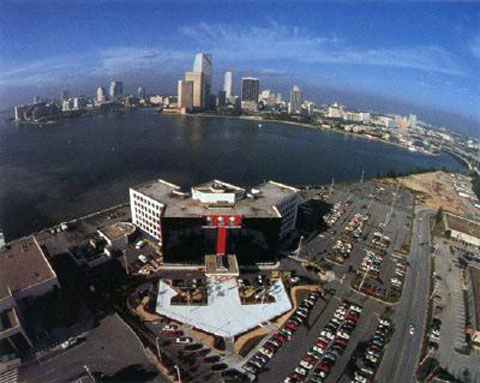
Royal Caribbean's headquarters in Miami, Florida
An idea that's also important to keep in mind is that cruise ships have a life expectancy of about 25 years. So one of the biggest questions was: what will Royal Caribbean customers want in 2010? Will the cruise ship we're trying to build now be still relevant then?
Hence, the first talks about Project Eagle were focused on trying to come up with innovative ideas for new vacation options. Most of the major concepts that make the Voyager-class ships so unique where brought up back then —the ice rink, for example. What Royal Caribbean executives had not anticipated, however, was that all those new passenger spaces would add up to form a whopping 140,000-ton ship — 40% larger than originally expected.

Harri Kulovaara
It is at this early stage of the project that newly-hired VP of Quality Assurance Harri Kulovaara suggested the idea of a huge open space in the middle of the ship that would interconnect most of the large public spaces and be the center of passenger life onboard the ship. The idea was evocative of one of Kulovaara's previous design of a ferry for Silja Lines. This 120-meter atrium, that would end up as the Royal Promenade, was however very far from being an obvious choice or an easy decision: it was a bet that could also have ended up as a hollow center inside the world's largest cruise ship.
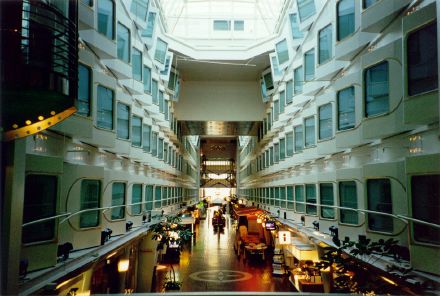
Silja Symphony's indoor promenade
Part 2: Managing a huge design project
Project Eagle was so huge, it required something of a complete shakeup of Royal Caribbean's newbuilding department.
What has to be understood here, is that Royal Caribbean is pretty unique in the way it handles ship design. Unlike its archrival Carnival Cruises, which only relies on its one single architect for both interior and general planning — with the very poor results most shiplovers acknowledge — Royal Caribbean is focused on delegating design responsibilities to a myriad of different people, all carefully chosen ("Execution is relatively easy, compared with finding talent," Kulovaara says. "It's more important that the designers know what they are doing than that they live in a convenient place.")
Once the basic layout was complete, the design of each public space was assigned to a particular architect or design firm — some having no cruise ship experience yet. The role of these small groups was to come up with clever designs and an absolute focus on every detail for the particular area(s) assigned to them, supervising everything from decor to furnishing to construction quality inspections at the shipyard. Starting in 1997, this dozen outside consultants reported to Project Manager Gunnar Bjørn and Technical Director Olav Eftedal in Oslo.
Then, at Royal Caribbean's headquarters in Miami, were held steering committee sessions (quite unlike those most companies are familiar with, lasting for a couple of days or more in most cases). These involved:
- on one side of the table: Richard Fain — Chairman & CEO, Harri Kulovaara — newly promoted Senior VP of Marine Operations, Jack Williams — President, Royal Caribbean International, and a few more veteran Royal Caribbean executives forming the so-called Miami Eagles, each in charge of a department affecting construction or use of shipboard space, such as Hotel Services, Shipboard Revenue or Entertainment.
- on the other side: architects and engineers from the Newbuilding Department in Oslo, headed by Technical Director Olav Eftedal.
- in addition, all the outside consultants, designers and artists in charge of the particular room that was being discussed at the session.

Jack Williams, Richard Fain & Harri Kulovaara
At each of these meetings, Richard Fain, whose reputation for ship design is known industry-wide, liked to challenge every architect or designer about the most trivial matters as well as the most critical issues to make sure they were 100% reliable and had strong convictions about their proposals. This was his way to make sure quality and care for design were being treated with the required concern at every level of the organization. The committee oversaw design as well as cost and overall progress on the project, while most of the planning was being taken care of by Eftedal's team at the Newbuilding Department in Oslo.
Part 3: Making way for the construction
It would be fool to believe all design issues were being taken care of by the design firms and during steering-committee sessions. Project Eagle was about designing a ship, and like any ship, it required tremendous work from naval architects and engineers to make sure the floating palace envisioned in Miami was an efficient steel structure that could handle rough seas while guaranteeing passenger comfort.
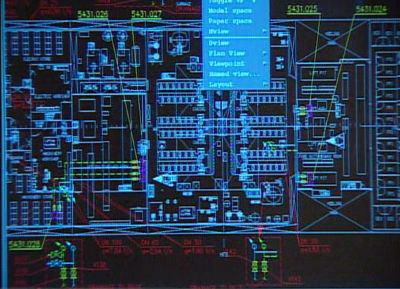
Deck 0
This complex task begins with hull shape design, fuel and deadweight requirements, and is being discussed as soon as the ship size and number of passenger cabins are approximatively determined. The second step is the testing of a huge scale model of the future hull in an immense basin:
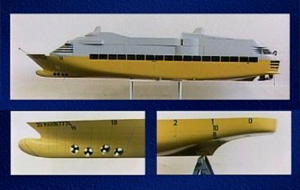
The first hull prototype for Voyager of the Seas
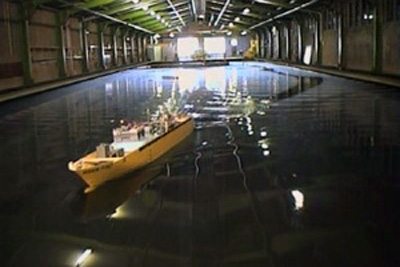
Basin testing
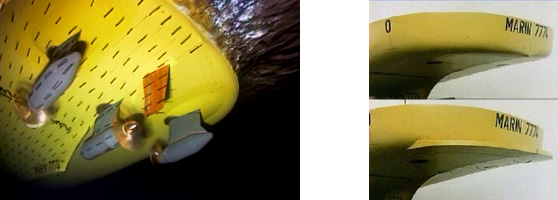
The prototype's stability was enchanced by two improvements added after the results of the early basin tests: a vertical stabilizer (left) and the "ducktail" (right)
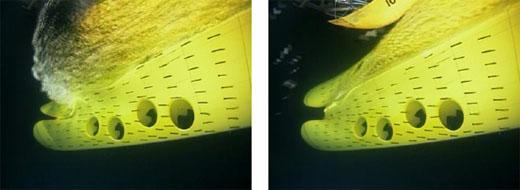
An efficient bulbous bow design (right) vs. a bad one (left)
Once Voyager was built, most of the design work had already been done. All changes in the subsequent sisterships would be quite minor design enhancements, and different decor and furnishing. Thus, less people were involved in the design process: starting in 2001, the Newbuilding Dpt. moved from Oslo to Miami, and Juhani Pitkanen was promoted Technical director for all newbuilds (including the remaining Voyager ships), while a Site manager was appointed at the Finnish shipyards to take care of the day-to-day problems facing construction.
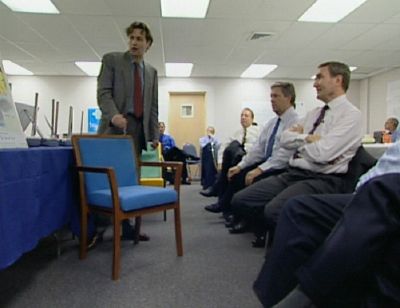
A decorator facing CEO Richard Fain in Miami
Part 4: Construction
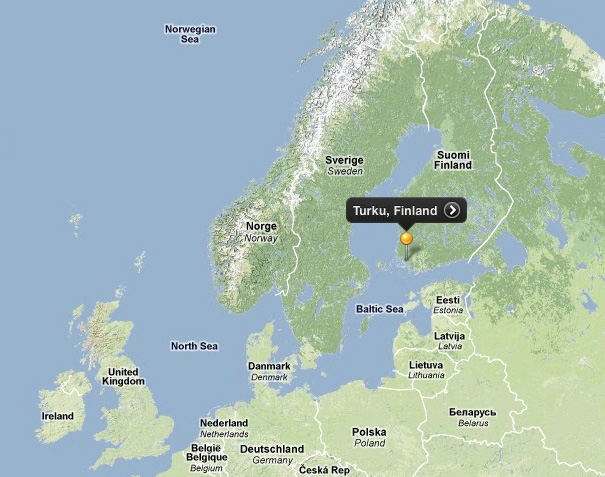
The first step is the manufacturing of individual components and panels, which will later be put together in the prefabrication zone, forming enormous blocks. These components cannot be purchased ready-made — most of them are large parts of the hull. Sheets of metal are cut out using plasma, laser or oxyacetylene equipment, then are welded and transformed into decks or bulkheads etc., which are to be put together into panels. The forming of profiles and specific sheets occurs at this stage as well.
In parallel, products that cannot be bought on the open market either, but that aren't part of the structure, are also being put together: it's the case of pipes, spacers, bolts, threaded connector rods, sea cocks, inspection hatch covers, hatch handles, pipe collars.
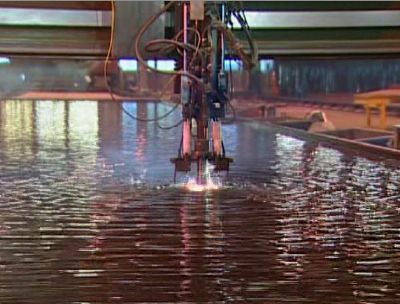
The first steel cut for the construction of newbuild No. 1344 (Voyager of the Seas) using a plasma steel-cutting machine
Once these 'home-made' components are built, prefabrication can start. The assembly process consists of turning individual spans into panels, or putting together metal assemblies made up of welded sheets that will eventually form the vessel's hull. The shaping workshop produces all curved pieces (plating, bulb, superstructure) of the vessels, which will later be assembled on the prefabrication lines.
Pre-fitting consists of equipping the panels or blocks with pipe work, ventilation ducts, electrical cabling, etc. prior to their assembly within the hull. This stage is important since it allows a decrease in the proportion of the fitting-out task, which is carried out aboard the vessel — in more difficult working conditions than in the workshops.
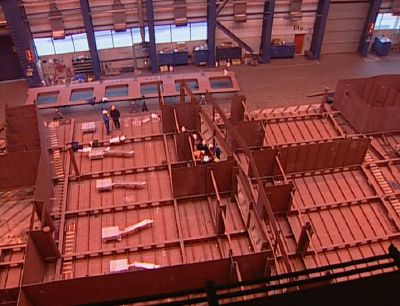
A pre-fitting workshop at Kværner Masa-Yards during the construction of NB No. 1344 Note that workers equip the panels upside down to ease the process (much of the cables, air ducts, pipes, etc. being located in the ceiling)
The last fitting session prior to the assembly of the vessel is called the block stage. Just like the panel fitting, it deals with the installation of pipes, ventilation ducts, electrical cable runs, insulation, etc. as well as modules (pipe-work assemblies, electric motors, generators...) — in short, all the assemblies which are delivered ready-to-fit. Then all the panels are put together to form sub-assemblies of the vessel (i.e. blocks), each weighing several hundred tonnes. Wedged in one against another, these colossusses slowly begin to resemble pieces of a massive jigsaw puzzle.
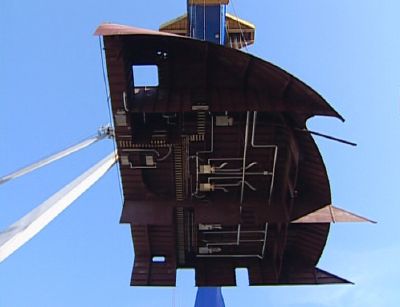
A small block (a forward part of Voyager) being lifted before its welding to the ship. Notice the pipes and cables installed during the pre-fitting stage.
The assembly process can be considered as the finalisation of all the work carried out by those involved upstream. On its keel, the vessel is finally starting to take form: little by little, what was initially just a collection of blocks is turning into a cruise ship.
The assembly process starts with the keel laying. It consists of transferring the blocks, one after the other, from the pre-assembly zone to the construction dock. The first blocks are located in the lower, middle section of the vessel. Then, the soon-to-be cruise ship grows from bottom to top and from center to ends.
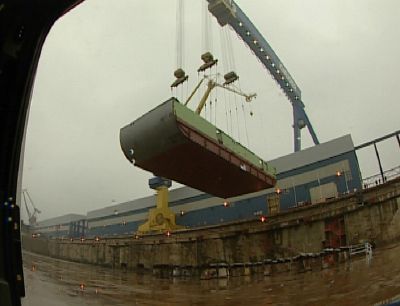
The first block of NB No. 1344 being lifted into the building dock.
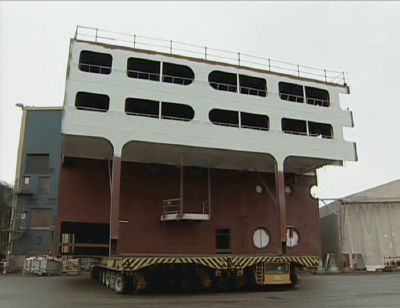
One block being transported from the pre-assembly zone to the building dock by a dedicated huge truck. The embarkations deck and the balconies of decks 6 and 7 are clearly recognizable.
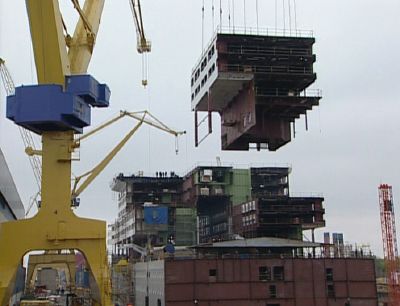
The same block being lifted by one of the yard's gigantic crane before its welding into the whole structure. Voyager's Royal Promenade is taking shape.
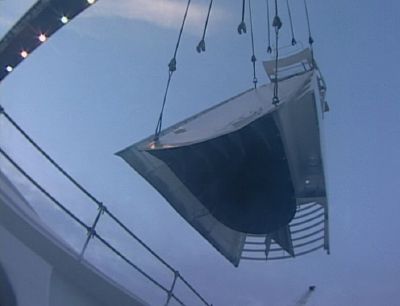
The last block to be fitted out is the aft stack up on deck 13
Once all the blocks are welded together to form the complete ship, it is time to float the vessel out. The dock is flooded with water and the dock gates are opened, allowing the vessel to touch her element for the first time. Then, she is moved to the fitting-out quay.
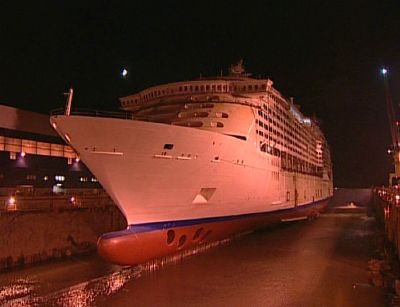
NB 1344 being floated out on Nov. 27, 1998
Fitting out a vessel means completing her with all the equipment required to make her operational — a series of operations which start in fact as early as the keel laying, with the installation of the engines (which cannot be done during the pre-fitting process).
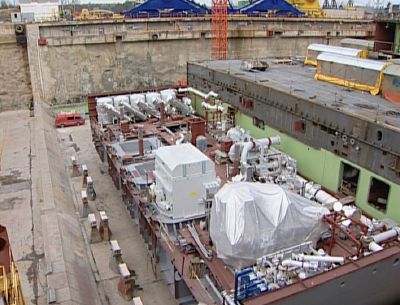
The first step of the fitting-out process: the installation of the machinery on the lowest deck. The masssive white block in the center is one of the six electric generators.
Then the support work is getting its finishing touches (i.e. the mounting of pipework, ducts, etc) to allow the set up of phonic, thermal and fire insulations.
Most of the fitting-out occurs later on, alongside the dedicated dock (the fitting-out quay)
At this stage, the pipework system is subjected to 'proving tests' (the pipes and ducts are pressurized in order to detect possible leaks), the temporary lighting and fire protection networks are being replaced by their final versions, the galleys are equipped and the prefabricated passengers cabins are fitted (only the larger suites being built directly aboard).
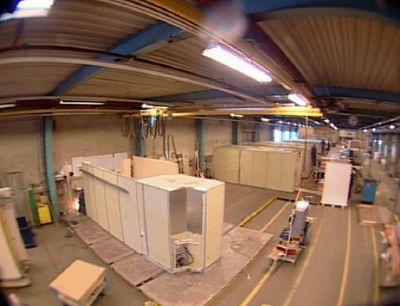
The Pikiio factory in Turku, where the vast majority of Voyager's cabins are prefabricated.
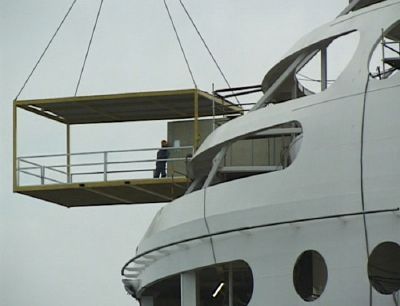
A prefabricated cabin being loaded into the ship through the upper stern structure, before it is connected to the air-conditioning, water and electric networks.
Then comes the work on the internal partitioning and various paintwork, wall covering, décor, etc. The last step is the floor covering (carpets, teak planking...) to prevent any damage before the ship hand-over.
Fitting-out of Newbuild No. 1344
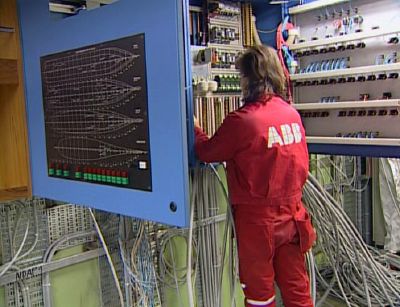
Installation of an electric substation
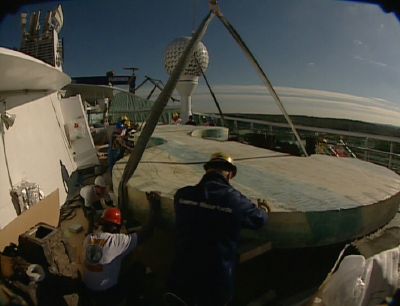
One block of the miniature golf — manufactured in New Hampshire
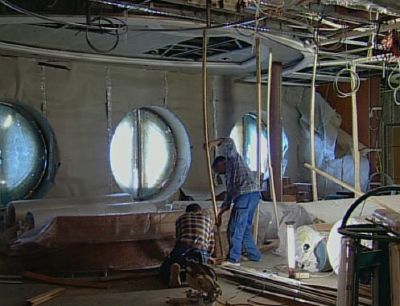
The Schooner Bar during fitting-out
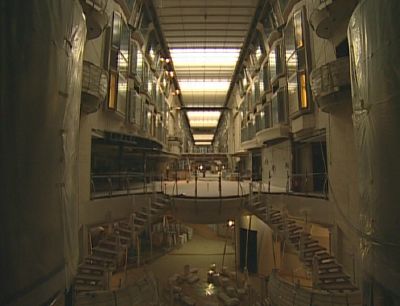
The forward Centrum and Royal Promenade
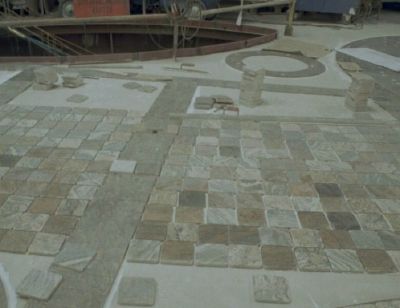
Tiles on the floor of the Promenade
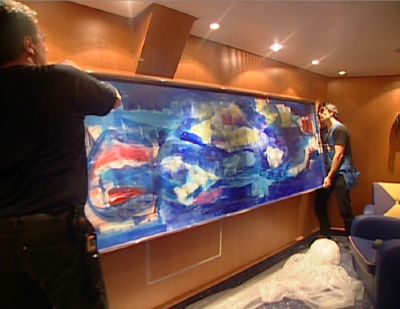
The installation of the artwork is one of the latest stage of the fitting-out process. Due to an onboard fire, Voyager's construction was delayed and this step took place during her transatlantic crossing.
The first trials occur alongside the fitting-out quay.
The vessel's main electrical switchboard is turned on first, followed by the propulsion system (for berthing manoeuvres), the electrical production plant, the lighting, pumps and ventilation systems and the security systems (fire detectors, extinguishers, indications...). The first acoustic and vibration tests are also carried out at this time; they will be validated later on, during the sea trials.
As much as 90% of the trials are carried out at this stage.
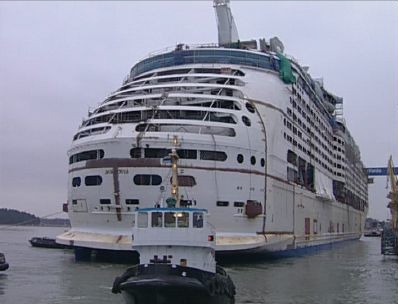
Voyager of the Seas being carried along the fitting-out quay.
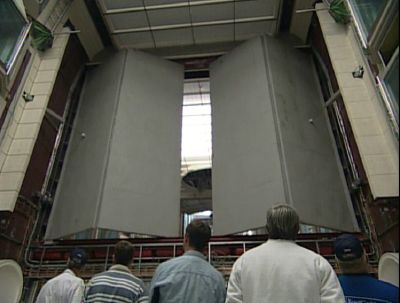
One of Voyager's most critical test is that of the Royal Promenade's firedoors, whose revolutionary design has been put into question since the beginning.
The sea trials is the last major stage of the construction process. The vessel is finally operating in real-life conditions, under careful surveillance from Royal Caribbean's own representatives as well as specialists from the US Coast Guards and Det Norske Veritas (a well-reknowned classification society).
The shipowner's engineers are aboard to validate a number of contractual measurements, such as the vibration levels and maximum speed. The DNV and USCG people are here to make sure the newbuild complies with the latest international regulations. Indeed, the ship will not be allowed to sail unless their organizations have given their final approval. This requires several compulsory trials, all standardized and coded with great detail.
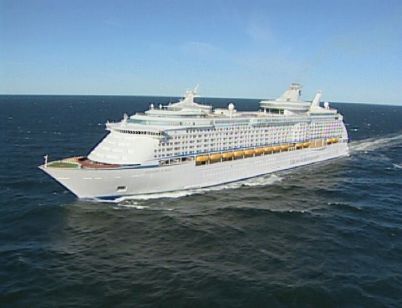
Voyager during her sea trials.
Once the ship has been fully validated and completed, the delivery protocol is signed. The shipyard's President and the shipowner's CEO, Richard Fain in the case of the Voyager-class ships, initial the documents which testify to the legal change of ownership of the newbuild: from this moment on, she belongs to the cruise company.

Richard Fain (left) signing Voyager of the Seas' delivery protocol, next to Kvaerner Masa-Yards President & CEO Martin Saarikangas
The finale is the ceremony of flag switching — i.e. when the shipowner's flag replaces that of the shipyard. Voyager's flag switching was celebrated in the ship's own theater, La Scala.
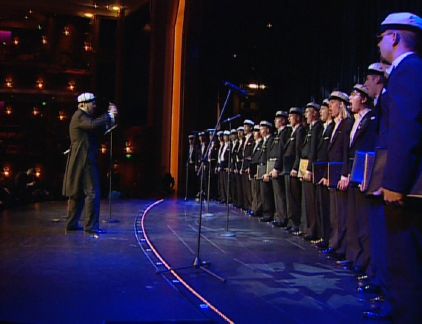
A Finnish choir singing on La Scala's stage while Royal Caribbean's flag was being raised on Voyager's forward mast.